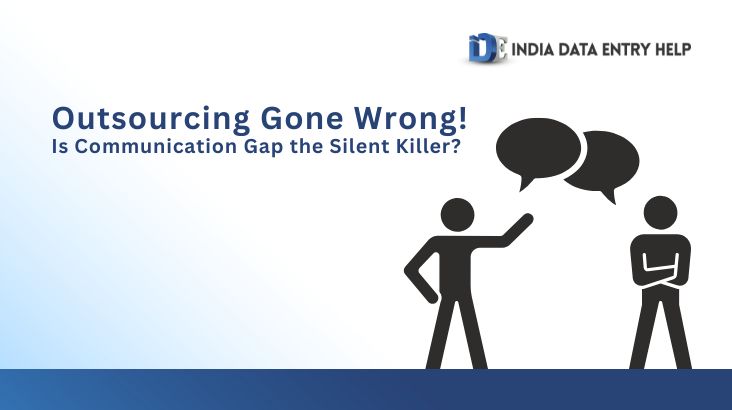Consider a company outsources its app development project to a service provider overseas. Every process is perfectly handled, the deadlines are met, the code was written well, and the day for the demo arrives. But what they launched is far from the client’s expectations. The features they required were missing, the UI feels cumbersome, and the whole user flow is off. But what was the primary reason behind these?
It was not the skill of the developer, the deadline, or the budget overruns. It was clear communication that had never really happened. The assumptions they had left unchecked, and the emails that meant one thing to the sender and another to the receiver. Communication gaps are a serious issue that is often ignored. It can even break the strongest outsourcing plans. So, let’s explore how this silent issue causes chaos and how it can be prevented.

Common Outsourcing Misconception
Usually, when outsourcing fails, people believe the failure is caused by various issues, including poor product quality, delayed delivery, and budget inflation. But these are usually symptoms.
But these are usually symptoms. The real problem often hides in plain sight. A communication gap quietly undermines progress. Misunderstandings grow. Feedback loops shrink. Eventually, small misalignments snowball into major breakdowns. Companies need to stop treating communication as a checkbox and start viewing it as the core strategy.
What the Data Says About the Cost of Silence
The numbers speak clearly. According to a PMI report, poor communication causes one-third of all project failures. Another study by Salesforce found that 86% of employees cite a lack of collaboration or ineffective communication as a reason for failures at work.
Now apply that to outsourcing, where distance, time zones, and culture amplify these issues. Miscommunication in remote teams isn’t just about language. It’s about missing tone, unspoken assumptions, and unclear context. Every missed message or misunderstood directive costs time, money, and trust.
Breaking Down the Communication Gap
So, how does this gap form?
- Time Zone Lags: A 12-hour difference turns a quick question into a 24-hour delay.
- Cultural Cues: In some cultures, saying “yes” means acknowledgment, not agreement. That distinction can derail expectations.
- Documentation Issues: Vague requirements leave room for interpretation. That room often leads to wrong turns.
- Feedback Silence: In global settings, silence can mean confusion, disagreement, or even politeness, but rarely means approval.
Take the case of a company outsourcing data entry services. The client requested “accurate and clean records.” The offshore team focused solely on spelling and grammar, overlooking formatting consistency and data categorization. Why? “Clean” meant an organized structure to the client, but simply error-free text to the vendor.
Language is Not Always the Problem
- Think beyond English fluency. Communication styles vary across cultures.
- High-context cultures (like Japan, India) often imply messages, relying on context.
- Low-context cultures (like the U.S., Germany) value directness and explicit information.
This difference impacts everything, how feedback is given, how problems are reported, and how updates are shared. Additionally, cultural intelligence is not optional. It is essential.
Significance of Tone in Communication
Another common gap is tone. Some cultures prefer indirect criticism. Others appreciate blunt feedback. When these clash, intentions are misunderstood. A client’s direct feedback may seem harsh to a team that values politeness. A team’s vague responses might feel evasive to a client who wants clarity. This mismatch affects trust. When people feel judged or ignored, collaboration suffers. Additionally, building mutual respect and psychological safety allows teams to speak openly without fear of offending or being dismissed.
Can Tech Really Solve the Talk?
Tools like Slack, Zoom, Jira, and Trello help. But they don’t guarantee understanding. Many companies think installing communication software solves the problem. It doesn’t. In fact, over-reliance on tools can create noise instead of clarity. For example, too many Slack channels can overwhelm teams. Long Jira threads without summaries confuse developers. Zoom meetings without agendas waste time. Technology needs structure. Without clear communication processes, tools become cluttered message boards.
A Communication Framework That Works
To avoid these pitfalls, create a clear, consistent framework:
- Single Point of Contact: Assign dedicated leads on both sides.
- Regular Syncs: Weekly video calls, not just email check-ins.
- Shared Docs: Centralize specs, feedback, and revisions.
- Visual Feedback: Use mockups, screen recordings, and prototypes.
- Escalation Plan: Define who steps in when things are delayed.
Start every project with a communication blueprint. It sets expectations, timelines, and responsibilities. It also reduces guesswork and builds trust. Also, share a sample brief or checklist during onboarding. It avoids assumptions.
What Successful Companies Do to Prevent Communication Gaps?
Here are some of the factors to consider to have efficient communication while outsourcing:
- Clear rules for when and how to communicate.
- Teams should learn about each other’s customs, holidays, and norms.
- Everything from meeting notes to project goals should be documented.
These habits reduce friction and create transparency. Their communication is not reactive. It is intentional.
Outsourcing offers many benefits, including speed, cost savings, and scalability. But none of that matters if communication fails. Companies often spend weeks selecting the right technology stack, but barely a day designing their communication process. Therefore, if you want your outsourcing projects to succeed, take some efficient strategies to facilitate effective communication. Before you sign your next outsourcing contract, make sure your communication plan is as strong as your project brief. Because it is not the message that matters. It’s how it is heard.
Looking for a reliable outsourcing partner with clear communication and transparency? Then we are your ideal partner. Connect with us at [email protected] to know more.



